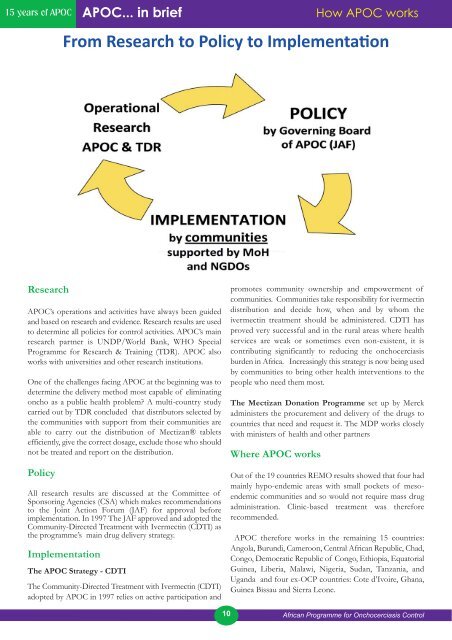15 years of APOC - World Health Organization
15 years of APOC - World Health Organization
15 years of APOC - World Health Organization
You also want an ePaper? Increase the reach of your titles
YUMPU automatically turns print PDFs into web optimized ePapers that Google loves.
<strong>15</strong> <strong>years</strong> <strong>of</strong> <strong>APOC</strong><br />
Research<br />
<strong>APOC</strong>... in brief How <strong>APOC</strong> works<br />
<strong>APOC</strong>’s operations and activities have always been guided<br />
and based on research and evidence. Research results are used<br />
to determine all policies for control activities. <strong>APOC</strong>’s main<br />
research partner is UNDP/<strong>World</strong> Bank, WHO Special<br />
Programme for Research & Training (TDR). <strong>APOC</strong> also<br />
works with universities and other research institutions.<br />
One <strong>of</strong> the challenges facing <strong>APOC</strong> at the beginning was to<br />
determine the delivery method most capable <strong>of</strong> eliminating<br />
oncho as a public health problem? A multi-country study<br />
carried out by TDR concluded that distributors selected by<br />
the communities with support from their communities are<br />
able to carry out the distribution <strong>of</strong> Mectizan® tablets<br />
efficiently, give the correct dosage, exclude those who should<br />
not be treated and report on the distribution.<br />
Policy<br />
From Research to Policy to Implementation<br />
All research results are discussed at the Committee <strong>of</strong><br />
Sponsoring Agencies (CSA) which makes recommendations<br />
to the Joint Action Forum (JAF) for approval before<br />
implementation. In 1997 The JAF approved and adopted the<br />
Community-Directed Treatment with Ivermectin (CDTI) as<br />
the programme’s main drug delivery strategy.<br />
Implementation<br />
The <strong>APOC</strong> Strategy - CDTI<br />
The Community-Directed Treatment with Ivermectin (CDTI)<br />
adopted by <strong>APOC</strong> in 1997 relies on active participation and<br />
10<br />
promotes community ownership and empowerment <strong>of</strong><br />
communities. Communities take responsibility for ivermectin<br />
distribution and decide how, when and by whom the<br />
ivermectin treatment should be administered. CDTI has<br />
proved very successful and in the rural areas where health<br />
services are weak or sometimes even non-existent, it is<br />
contributing significantly to reducing the onchocerciasis<br />
burden in Africa. Increasingly this strategy is now being used<br />
by communities to bring other health interventions to the<br />
people who need them most.<br />
The Mectizan Donation Programme set up by Merck<br />
administers the procurement and delivery <strong>of</strong> the drugs to<br />
countries that need and request it. The MDP works closely<br />
with ministers <strong>of</strong> health and other partners<br />
Where <strong>APOC</strong> works<br />
Out <strong>of</strong> the 19 countries REMO results showed that four had<br />
mainly hypo-endemic areas with small pockets <strong>of</strong> mesoendemic<br />
communities and so would not require mass drug<br />
administration. Clinic-based treatment was therefore<br />
recommended.<br />
<strong>APOC</strong> therefore works in the remaining <strong>15</strong> countries:<br />
Angola, Burundi, Cameroon, Central African Republic, Chad,<br />
Congo, Democratic Republic <strong>of</strong> Congo, Ethiopia, Equatorial<br />
Guinea, Liberia, Malawi, Nigeria, Sudan, Tanzania, and<br />
Uganda and four ex-OCP countries: Cote d’Ivoire, Ghana,<br />
Guinea Bissau and Sierra Leone.<br />
African Programme for Onchocerciasis Control

















